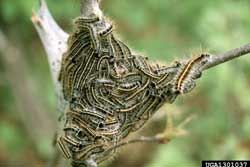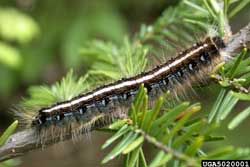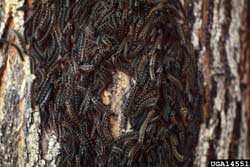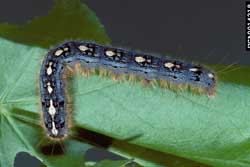Tent Caterpillars
Tent caterpillars attack several kinds of broadleaf trees and shrubs and produce unsightly webs, or tents. Trees with substantial defoliation will have reduced growth and vigor. The caterpillars often occur in large numbers which can be a nuisance around homes.
Eastern Tent Caterpillars
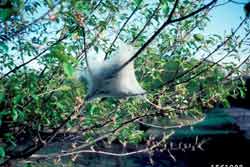
Eastern tent caterpillars feed on new leaves, forming small webs within a few days after hatching and enlarging the webs as they grow.
Forest Tent Caterpillars
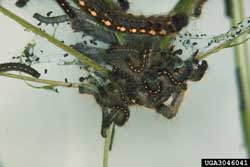
Forest tent caterpillars build mats of webbing rather than tents. They forage in all directions from these mats but return to the colony when not feeding. Caterpillars feed actively for five to six weeks.
Click on images to view full-size
Identification and Control Information
- Tent Caterpillars—Maine Forest Service
- Eastern Tent Caterpillar (PDF)—University of Wisconsin Cooperative Extension
- Fact Sheet: Eastern Tent Caterpillar—University of Kentucky Cooperative Extension Service
- Forest and Eastern Tent Caterpillars—University of Maine Cooperative Extension
- Tent Caterpillars (including eastern and forest tent caterpillars and fall webworm)—University of Kentucky Cooperative Extension Service
More Information
- Maine Forest Service: Conditions Reports (updated regularly) including annual summary reports
[Photos, left to right: Catherine Herms, The Ohio State University, Bugwood.org; Joseph O'Brien, USDA Forest Service, Bugwood.org; Pennsylvania Department of Conservation and Natural Resources - Forestry Archive, Bugwood.org; R.C. Morris, USDA Forest Service, Bugwood.org; Whitney Cranshaw, Colorado State University, Bugwood.org; Gerald J. Lenhard, Louiana State Univ, Bugwood.org]
